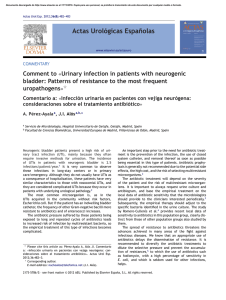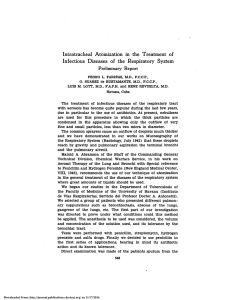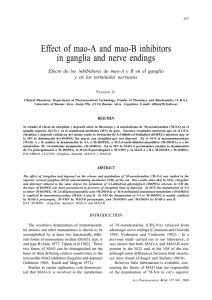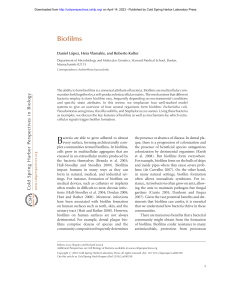Lack of beta–lactamases in Pseudomonas aeruginosa of animal
Anuncio
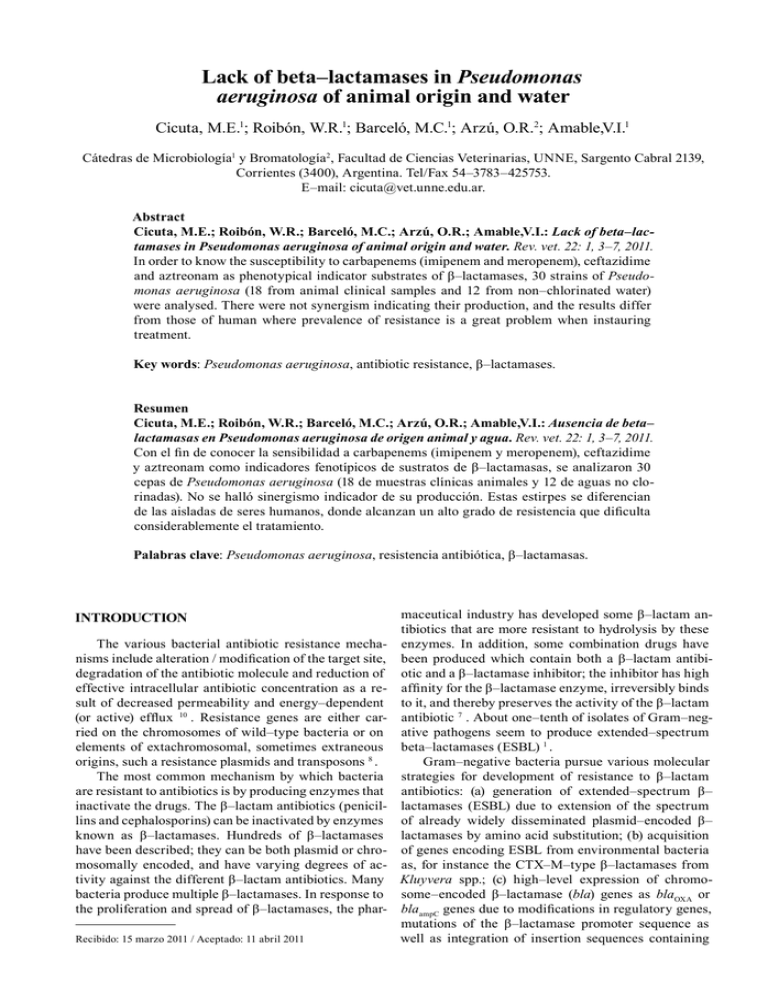
Lack of beta–lactamases in Pseudomonas aeruginosa of animal origin and water Cicuta, M.E.1; Roibón, W.R.1; Barceló, M.C.1; Arzú, O.R.2; Amable,V.I.1 Cátedras de Microbiología1 y Bromatología2, Facultad de Ciencias Veterinarias, UNNE, Sargento Cabral 2139, Corrientes (3400), Argentina. Tel/Fax 54–3783–425753. E–mail: [email protected]. Abstract Cicuta, M.E.; Roibón, W.R.; Barceló, M.C.; Arzú, O.R.; Amable,V.I.: Lack of beta–lactamases in Pseudomonas aeruginosa of animal origin and water. Rev. vet. 22: 1, 3–7, 2011. In order to know the susceptibility to carbapenems (imipenem and meropenem), ceftazidime and aztreonam as phenotypical indicator substrates of β–lactamases, 30 strains of Pseudomonas aeruginosa (18 from animal clinical samples and 12 from non–chlorinated water) were analysed. There were not synergism indicating their production, and the results differ from those of human where prevalence of resistance is a great problem when instauring treatment. Key words: Pseudomonas aeruginosa, antibiotic resistance, β–lactamases. Resumen Cicuta, M.E.; Roibón, W.R.; Barceló, M.C.; Arzú, O.R.; Amable,V.I.: Ausencia de beta– lactamasas en Pseudomonas aeruginosa de origen animal y agua. Rev. vet. 22: 1, 3–7, 2011. Con el fin de conocer la sensibilidad a carbapenems (imipenem y meropenem), ceftazidime y aztreonam como indicadores fenotípicos de sustratos de β–lactamasas, se analizaron 30 cepas de Pseudomonas aeruginosa (18 de muestras clínicas animales y 12 de aguas no clorinadas). No se halló sinergismo indicador de su producción. Estas estirpes se diferencian de las aisladas de seres humanos, donde alcanzan un alto grado de resistencia que dificulta considerablemente el tratamiento. Palabras clave: Pseudomonas aeruginosa, resistencia antibiótica, β–lactamasas. INTRODUCTION The various bacterial antibiotic resistance mechanisms include alteration / modification of the target site, degradation of the antibiotic molecule and reduction of effective intracellular antibiotic concentration as a result of decreased permeability and energy–dependent (or active) efflux 10 . Resistance genes are either carried on the chromosomes of wild–type bacteria or on elements of extachromosomal, sometimes extraneous origins, such a resistance plasmids and transposons 8 . The most common mechanism by which bacteria are resistant to antibiotics is by producing enzymes that inactivate the drugs. The β–lactam antibiotics (penicillins and cephalosporins) can be inactivated by enzymes known as β–lactamases. Hundreds of β–lactamases have been described; they can be both plasmid or chromosomally encoded, and have varying degrees of activity against the different β–lactam antibiotics. Many bacteria produce multiple β–lactamases. In response to the proliferation and spread of β–lactamases, the pharRecibido: 15 marzo 2011 / Aceptado: 11 abril 2011 maceutical industry has developed some β–lactam antibiotics that are more resistant to hydrolysis by these enzymes. In addition, some combination drugs have been produced which contain both a β–lactam antibiotic and a β–lactamase inhibitor; the inhibitor has high affinity for the β–lactamase enzyme, irreversibly binds to it, and thereby preserves the activity of the β–lactam antibiotic 7 . About one–tenth of isolates of Gram–negative pathogens seem to produce extended–spectrum beta–lactamases (ESBL) 1 . Gram–negative bacteria pursue various molecular strategies for development of resistance to β–lactam antibiotics: (a) generation of extended–spectrum β– lactamases (ESBL) due to extension of the spectrum of already widely disseminated plasmid–encoded β– lactamases by amino acid substitution; (b) acquisition of genes encoding ESBL from environmental bacteria as, for instance the CTX–M–type β–lactamases from Kluyvera spp.; (c) high–level expression of chromosome–encoded β–lactamase (bla) genes as blaOXA or blaampC genes due to modifications in regulatory genes, mutations of the β–lactamase promoter sequence as well as integration of insertion sequences containing Cicuta M.E. et al.: β-lactamasas en P.aeruginosa. Rev. vet. 22: 1, 3–7, 2011 4 an efficient promoter for intrinsic bla genes; (d) mobilization of bla genes by incorporation in integrons and horizontal transfer into other Gram–negative species such as the transfer of the ampC gene from Citrobacter freundii to Klebsiella spp.; (e) dissemination of plasmid–mediated carbapenemases as KPC and metallo–β– lactamases, e.g. VIM and IMP; (f) non–expression of porin genes and/or efflux pump–based antibiotic resistance 17 . Pseudomonas aeruginosa exhibits resistance to a variety of penicillins and cephalosporins, mediated by an alteration in porin proteins that form channels in the cell membrane 7 . The best–studied members of these pumps are the MexAB–OprM system of Pseudomonas aeruginosa that are known to efflux antibiotics, heavy metals, dyes, detergents, solvents, plus many other substrates 18 . Drug efflux systems pump out a broad range of chemically and structurally unrelated compounds from bacteria in an energy–dependent manner, without drug alteration or degradation 16 . Although drug efflux pumps are found in Gram–negative and Gram–positive bacteria, efflux mediated resistance in Gram–negative bacteria is a more complex problem due to the molecular architecture of the cell envelope. As a consequence, drug resistance in many cases is attributable to synergy between reduced drug intake (mainly due to low outer membrane permeability) and active drug export (via efflux pumps) 12 . The MexAB–OprM system of P. aeruginosa contributes to the antimicrobial resistance of wild–type strains and has the broadest substrate range of all characterized P. aeruginosa efflux pumps. Substrates of this pump include β–lactams, β–lactamase inhibitors, quinolones, macrolides, tetracyclines, chloramphenicol, novobiocin, sulfonamides, trimethoprim and thiolactomycin 9 . P. aeruginosa is a leading cause of nosocomial infections in public health. Carbapenem are potent agents for the treatment of this pathogen. However, the prevalence of carbapenem resistance among these bacteria has been increasing worldwide, particularly those me- Cftz Azt diated by acquired metallo–ß–lactamase (MBLs) 14 . MBLs eclipse the clinical efficacy of several broad– spectrum ß–lactam antibiotics and the existing ß–lactamase inhibitors. Moreover, the genetic elements usually associated with MBLs genes, facilitate their fast and widespread dissemination. Additionally, infections attributable to MBL–producing bacteria have been associated with an increased morbility and mortality 15 . P. aeruginosa is frequently isolated from canine otitis in this region. From 882 canine otitis swabs 222 strains were isolated. This indicates that it was the responsible ethiologic agent in 25.2% of cases of this pathology. The resistance to aminoglucosides was always over 50% with a maximun of 82.6% to amikacin and 81.4% to gentamicin. Low resistence to piperacillin (5.6%), fluoroquinolons (11.3%) and the polipeptide colistin (23%), resting the ultimate antibiotics to threat the infection. Similar susceptibility we obtained from P. aeruginosa isolated from another animal clinical samples such as nasal, bronchial, conjuntival, vaginal and piodermitis swabs. We did not know the resistant pattern of this bacteria from non–chlorinated water, obtained by perforation, of this region. So we analysed carbapenems, ceftazidime and aztreonam as phenotypical indicator substrates of β–lactamases 2 in the strains of both origin. MATERIAL AND METHODS Thirty strains of P. aeruginosa (18 from pathological clinical samples: 10 canine otitis, 3 ant–bear fecal swabs, 2 diarrhoeic suckling–pig faeces, 2 rabbit abscess, 1 ovine purulent exudate and 12 from non–chlorinated water) were studied for their susceptibility to antibiotics such as polimyxin (300 U), colistin (10 μg), piperacillin (100 μg), gentamicin (10 μg) and ciprofloxacin (5 μg) using antibiotic–diffusion in agar Mueller– Hinton by Kirby–Bauer antibiogram 11 . The strains were also analysed to determine phenotipically the presence of MBL: monodiscs of ceftazidime (30 μg), aztreonam (30 μg), imipenem (10 μg), Im EDTA Im EDTA Cftz Mer Mer Figure 1. Antibiogram of P. aeruginosa of canine otitis (ExO884) susceptible to all antibiotics. Figure 2. Antibiogram of P. aeruginosa of canine otitis (ExO929) resistant to imipenem (Im = 21 mm) and sensitive to other antibiotics. Cicuta M.E. et al.: β-lactamasas en P.aeruginosa. Rev. vet. 22: 1, 3–7, 2011 5 Table 1. Percentage of sensibility of 30 strains of P. aeruginosa. n 18 12 origin clinical samples non–cholin. water Im Mer Azt Pip Cftz Coli Poli G Cipro 83.3 83.3 100 100 100 91.6 100 100 100 91.6 77.7 – – 100 66.6 83.3 66.6 66.6 Im: Imipenem, Mer: Meropenem, Azt: Aztreonam, Pip: Piperacillin, Cftz: Ceftazidime, Coli: Colistin, Poli: Polimyxin, G: Gentamicin, Cipro: Ciprofloxacin. meropenem (10 μg) and one of ethilendiaminotet- Table 2. Detail of resistance of 7 strains of P. aerugiraacetic (EDTA, 1 μmol) as MBL inhibitor, were used nosa to ß–lactam antibiotics. according the agar diffusion method 3, 11 . The test is ref. origin Im Mer Azt Cftz positive when there is synergism between EDTA and Ex O 929 canine otitis R (21) S (30) S (25) S (20) carbapenem discs 2 . Ex O 934 As 153 A8 A 10 A 12 A 13 RESULTS canine otitis ant–bear rectal non chol.water non chol.water non chol.water non chol.water R (21) R (11) S (23) S (22) R (19) R (21) S (35) S (30) S (36) S (30) S (30) S (35) S (25) S (24) S (25) R (10) S (24) S (25) S (21) S (20) R (17) S (25) S (25) S (22) Of 18 strains from animal clinical samples (Table 1) 100% were susceptible to meropenem, aztreonam, piperacillin and ceftazidime, 15/18 (83.3%) to imipenem, 14/18 (77.7%) to colistin and 12/18 (66.6%) to gen- Im: Imipenem, Mer: Meropenem, Azt: Aztreonam, Cftz: Ceftazidime, S: sensible, R: resistant. In brakets: diameter tamicin and ciprofloxacin. Of 12 strains from non–chlorinated water (Table of inhibition halos (mm). 1), 100% were susceptible to meropenem, piperacillin, and polimyxin, 11/12 (91.6%) to aztreonam and cefta- Table 3. Diameter average of inhibition halos of P. aezidime, 10/12 (83.3%) to imipenem and gentamicin and ruginosa from clinical samples and water (mm). 8/12 (66.6%) to ciprofloxacin. There was not synergism n origin Im Mer Azt Cftz between EDTA and carbapenem discs (Figures 1, 2, 3 clin.samples 25.2 34.3 29.1 24.9 and 4). The detail of seven strains found resistant to 18 ranks 11–40 27–50 21–45 18–40 one ß–lactam antibiotic and the diameter average of the inhibition halos are in Tables 2 and 3 respectively. non–ch.water 23.0 33.3 23.9 23.3 12 DISCUSSION ranks 19–27 28–40 10–28 17–25 Im: Imipenem, Mer: Meropenem, Azt: Aztreonam, Cftz: Ceftazidime. As the phenotypic screening was negative for detecting MBLs producing isolates, the resistance to imipenem observed in four of them, is more likely due to a bacteria to imipenem and meropenem 3 . This was not decrease in the expression of OprD, an outer membrane the case in this work, where all the strains susceptible protein channel that acts as the passage for imipenem to aztreonam were also sensitive to meropenem. entry in P. aeruginosa 13 . Owing that MBLs do not efReduced of outer membrane permeability results ficiently hydrolyse aztreonam, its sensibility would be in reduced antibiotic uptake, leading to low–level drug a good predictor of the enzyme presence in resistant resistance. In the presence of drug efflux pumps, the Cftz Cftz Im Gen EDTA Pip Gen EDTA Azt Mer Figure 3. Antibiogram of P. aeruginosa of ant–bear rectal swab (AsI53) resistant to imipenem (Im= 11 mm) and sensitive to other antibiotics. Im Pip Azt Mer Figure 4. Antibiogram of P. aeruginosa of non– chlorinated water (AI3) resistant to imipenem (Im= 21 mm) and sensitive to other antibiotics. 6 Cicuta M.E. et al.: β-lactamasas en P.aeruginosa. Rev. vet. 22: 1, 3–7, 2011 resistance is amplified multiplicatively by synergism between reduced uptake and active efflux. This effect has been shown in 12 isolates of P. aeruginosa, of animal origin 4 . The synergism of reduced uptake and efflux is most evident in the multiplicative action of the outer membrane permeability barrier and active efflux, which results in high–level intrinsic and/or acquired resistance in many clinically important Gram–negative bacteria 8 . This mechanism may be the responsible of the resistance found in the strains of this work. In contrast with public health where approximately 40% of P. aeruginosa isolates are resistant to ceftazidime, imipenem or levofloxacin 1 , direct selective pressure is the most probable culprit of increased resistance. The chances for horizontal transfer of resistance and even virulence genes are increased by merely putting together bacteria that do not often interact 19 . Carbapenem resistance in human clinical isolates of P. aeruginosa has risen notably in recent years. This bacteria has different mechanisms of carbapenem resistance such as decreased levels of OprD or overexpression of the MexAB–OprM efflux system. Also the emergence of MBL–producing bacteria is becoming a severe therapeutic problem 20 . The introduction of carbapenems in antimicrobial chemotherapy in humans resulted in emergence of carbapenem hydrolyzing β–lactamases (carbapenemases); first in P. aeruginosa and Acinetobacter spp., later in Enterobacteriaceae 5 . At present, various β–lactamases are widespread in nearly every Gram– negative pathogenic species. Often, these enzymes are responsible for therapy failure because of mediating multidrug–resistance. A rigorous surveillance network to track the evolution and spread of resistance is also needed and would probably result in significant savings in healthcare 21 . P. aeruginosa, recognized as human opportunistic pathogen is increasingly responsible for lethal nosocomial infections. Treatment options are dramatically declining worldwide. This species has emerged as a relevant animal pathogen too. This is a consequence of massive antibiotic use and the large versatile genome of this organism. The strains we have studied have demonstrated important resistance to aminoglucosides other than β–lactamases. We agree with some authors 6 that antimicrobial profiling of P. aeruginosa animal isolates may contribute to a better understanding of the development and the epidemiology of P. aeruginosa multi–drug resistance in our densely populated biosphere with increasing human–animal interactions. REFERENCES 1.Amabile–Cuevas CF. 2010 Antibiotic resistance in Mexico: a brief overview of the current status and its causes J Infect Dev Ctries 4: 126–131. 2.Arakawa Y, Shibata N, Shibayama K, Kurokawa H, Yagi T, Fujiwara H, Goto M. 2000. Convenient test for screening metallobeta–lactamase–producing gram–nega- tive bacteria by using thiol compounds. J Clin Microbiol 38: 40–43. 3.Asociación Argentina de Microbiología (AAM). 2009. Subcomisión de Antimicrobianos. Caracterización fenotípica de la resistencia a los β–lactámicos en Pseudomonas aeruginosa y Acinetobacter spp. http://www.aam.org.ar/ novedades/consenso%20BNN F%20Anexo.pdf. p. 10. 4.Beinlich KL, Chuanchuen R, Schweizer HP. 2001. Contribution of multidrug efflux pumps to multiple antibiotic resistance in veterinary clinical isolates of Pseudomonas aeruginosa. FEMS Microbiol Lett 198: 129–134. 5.Bush K. 1998. Metallo–beta–lactamases: a class apart. Clin Infect Dis 27 (Suppl. 1): S48–S53. 6.De Vos D, Vilela CL, Pitt T, Oliveira M, Griffiths L, Craven K, Awong–Tayler J, Jennes S, Bilocq F, Leitao A, Pirnay JP. 2008. Antibiotic resistance profiling of phenotypic and genomic characterized Pseudomonas aeruginosa isolates from animal and human origin Int J Infect Dis 12: 121–122. 7.Diekema DJ. 2008. Drug resistance. AccessScience (Portal of McGraw–Hill Co). http://www.accessscience.com. 8.Kumar A, Schweizer HP. 2005. Bacterial resistance to antibiotics: active efflux and reduced uptake. Adv Drug Deliv Rev 57: 1486–1513. 9.Li XZ, Ma D, Livermore DM, Nikaido H. 1994. Role efflux pump(s) in intrinsic resistance of Pseudomonas aeruginosa: active efflux as a contributing factor to b–lactam resistance. Antimicrob Agents Chemother 38: 1742–1752. 10.Li XZ, Zhang L, Poole K. 2000. Interplay between the MexA–MexB–OprM multidrug efflux system and the outer membrane barrier in the multiple antibiotic resistance of Pseudomonas aeruginosa. J Antimicrob Chemother 45: 433–436. 11.National Committee for Clinical Laboratory Standards. 2004. Performance standards for antimicrobial disk susceptibility tests; approved standard, 14th Informational Supplement (Wayne, USA), 8th ed, M2–A8. 12.Nikaido H. 2003. Molecular basis of bacterial outer membrane permeability revisited. Microbiol Mol Biol Rev 67: 593–656. 13.Ochs MM, McCusker MP, Bains M, Hancock RE. 1999. Negative regulation of the Pseudomonas aeruginosa outer membrane porin OprD selective for imipenem and basic amino acids. Antimicrob Agents Chemother 43: 1085–1090. 14.Pagniez G, Radice M, Cuirolo A, Rodríguez O, Rodríguez H, Vay C, Famiglietti A, Gutkind G. 2006. Prevalence of metallo–ß–lactamase in carbapenem resistant Pseudomonas aeruginosa at a university hospital of Buenos Aires City. Rev Argent Microbiol 38: 33–37. 15.Pasteran FG, Faccone D, Petroni AE, Rapoport M, Galas M, Vazquez M, Procopio A. 2005. Novel variant (blaVIM–11) of the metallo–ß–lactamase blaVIM family in a GES–1 extended–spectrum–ß–lactamase–producing Pseudomonas aeruginosa clinical isolate in Argentina. Antimicrob Agents Chemother 49: 474–475. 16.Paulsen IT, Sliwinski MK, Saier MH. 1998. Microbial genome analyses: global comparisons of transport capabilities based on phylogenies, bioenergetics and substrate specificities. J Mol Biol 277: 573–592. Cicuta M.E. et al.: β-lactamasas en P.aeruginosa. Rev. vet. 22: 1, 3–7, 2011 17.Pfeifer Y, Cullick A, White W. 2010 Resistance to cephalosporins and carbapenems in Gram–negative bacterial pathogens. Int J Med Microbiol 300: 371–379. 18.Poole K, Krebes K, McNally C, Neshat S. 1993. Multiple antibiotic resistance in Pseudomonas aeruginosa: evidence for involvement of an efflux operon. J Bacteriol 175: 7363–7372. 19.Rosas I, Amábile CF, Calva E, Osornio A. 2011. Health implications of animal and human waste as components of urban dust pollution. In: Encyclopedia of environmental health (Nriagu JO, ed.), Elsevier, Amsterdam, 757 p. 7 20.Sánchez A, Salso S, Culebras E, Picazo JJ. 2004. Resistencia a carbapenems por metaloenzimas en aislamientos clínicos de Pseudomonas aeruginosa. Rev Esp Quimioterapia 17: 336–340. 21.The American Academy of Microbiology. 2009. Antibiotic resistance: an ecological perspective on an old problem. http://academy.asm.org/images/stories/documen ts/ antibioticresistance.pdf. Revista Veterinaria ya registra “índice de impacto” Así lo informó The SCImago Journal & Country Ranks, un portal que difunde indicadores científicos de revistas internacionales, desarrollados a partir de la información contenida en la base de datos de Scopus (Elsevier), indicadores aptos para evaluar y analizar distintos dominios científicos. Para el período 1996-2008, el ranking latinoamericano de documentos citables incluyó países como Brasil (6804), Argentina (1186), México (1199), Venezuela (713), Chile (658), Uruguay (201) y Colombia (166). El resto de los países registró menos de 100 documentos citables en dicho período. En Argentina, para el rubro “Veterinaria” (1996-2008) se registraron 1096 documentos, de los cuales 1079 fueron citables, efectuándose 7617 citaciones. “Revista Veterinaria” (UNNE, Corrientes) registró un índice de impacto de 0,03. El indicador SJR mide la influencia científica promedio de los artículos de una publicación periódica, reflejando su participación en la discusión científica global de la disciplina considerada. El índice se calcula por medio de la fórmula Thomson Reuters, que se aplica para evaluar el factor de impacto de la revista. Fuente: http://www.scimagojr.com. Retrieved September 20, 2010.

